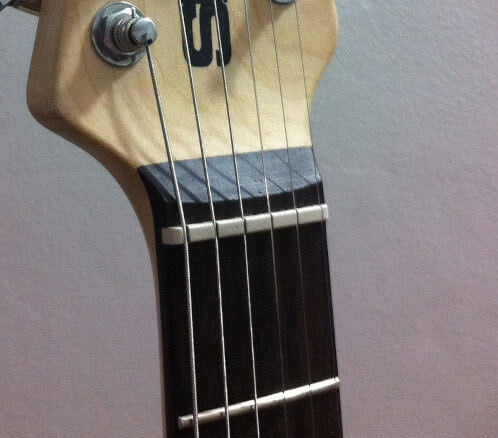Table of Contents
With age and many string changes, come wear! Eventually, your electric or acoustic guitar nut will work loose. Or, perhaps you have a worn nut that needs to be replaced.
Whatever the case, it’s going to need to be attached to the guitar neck. But what should you use to fasten it, guitar nut glue?
Guitar nut glue is not necessary. This is because the strings normally hold it in place when they are tuned correctly. But it’s suggested that the nut should be glued in place. This will help prevent it from falling off when the strings are removed.
This will help make it easier to change string as you won’t also have to try and keep the nut in place. In this Killer Rig article, we are going to explore different glue types for your guitar nut and suggest the best type.
The Best Guitar Nut Glue
So, what is the best guitar nut glue? We have looked at the reasons for gluing the nut and not using any at all. And we have also examined the pros and cons of using glue. Now it’s time to choose the best type of glue for the job.
Four main types of glue can be used for this purpose:
- Super or Crazy Glue.
- Titebond Wood Glue.
- Elmers Wood Glue.
- Hide Glue.
Crazy or superglue is the easiest to use. But it might make it hard to position the nut in the right place because it sets so quickly. It can also be difficult to remove the nut later on if you need to. It’s also the most likely to damage the guitar if it’s not used correctly.
Titebond and Elmers Wood Glue are better options. This is because they set slowly over time and are much easier to remove when you need to. They will hold the nut in place well enough to prevent it from moving when you play.
Hide glue is also a good option for gluing the guitar nut in place. It sets slowly and is very easy to remove if necessary. It’s also less likely to damage the guitar if it’s not used correctly. But it’s not as common as the other options.
Stewmac and other guitar builders normally recommend Titebond. And so we suggest you use it as well. I consider it to be the best glue for guitar nuts.
If you do decide to use crazy glue, use only one small drop. Try to be as accurate as you can when placing the nut down on the guitar.
These glue types are good for all guitar nut materials like Tusq, plastic, bone, and synthetics.
Do You Need To Glue A Guitar Nut In Place?
There is no need to use glue to hold the nut in place. This is because the strings add a great deal of pressure to the guitar nut when they are tuned. The only time you will wish you did is when you are trying to hold it in place while putting on new strings.
You see, when the new strings are being installed, the nut will want to move and even fall off of the guitar. If you are trying to use a winder while holding the string in place, the nut will be hard to also keep in place at the same time.
And so while it’s not completely necessary to glue it down, it can be handy. But there are reasons to keep it loose as well, which we will explore in this article.
Leaving The Nut Unglued
Some players prefer to leave the guitar nut unglued so that they can easily remove it. This is often done for two reasons:
- To be able to change guitar nuts for different string gauges.
- Makes nut replacement much easier.
Leaving it unglued also means that you will be able to remove it without damaging the guitar if you need to do so.
This can come in handy if you want to change the nut if it breaks or because it’s worn out and needs to be replaced.
Some players have also mentioned that gluing the nut affects the sound made by the guitar. And maybe I can see this being possible with certain types of glue. But I can’t imagine it being very noticeable.

Gluing The Nut: Pros And Cons
We have explored the reasons for and against gluing the guitar nut in place. Let’s now look at the pros and cons of using glue.
| Pros | Cons |
|---|---|
| Makes string changes much easier as you don’t have to worry about the nut falling off. | Makes it more difficult to change the nut if you need to. |
| Can help prevent the nut from shifting when playing on certain guitars. | Can damage the nut slot on the guitar if the glue is too aggressive. |
| May prevent any vibration noise on electric guitars with inadequate pressure at the nut. | Some glue might get into the nut slots if too much is used. |
How To Remove A Guitar Nut That Has Been Glued In Place
If you have a guitar nut that has been glued in place, and you need to remove it, there are a few things you can do.
- Use a heat gun or hair dryer on the glue. This will make it easier to remove the nut.
- Use a sharp knife to cut through the glue. Be careful not to damage the guitar.
- Lightly tap the nut with a punch or drift and a hammer to loosen the adhesive.
Once you have removed the guitar nut, you can then proceed to clean up any residue and leftover glue. If the guitar has a slot for the nut, all the glue left over must be removed.
If there is simply a flat spot for the nut, just make sure no high spots exist that will affect how the new one sits. It must be completely flat to prevent affecting the action.

Tips For Gluing a Guitar Nut
Here are some tips that will help you when gluing the guitar nut in place.
- Make sure the area where the nut will be glued is clean and free of any debris. A small amount of alcohol on a cotton swab can be used to clean the surface.
- Only use a small amount of glue, you don’t want any squeeze-out. If you do get some, you can clean it up with a damp paper towel.
- Place the nut in the correct position and restring the guitar. Once it is tuned to pitch, center the nut and leave it for 24 hours for the glue to set.
- Once the glue has set, you can clean or sand away any that may have been squeezed out.
If you do decide to use superglue, then it will set before you string the acoustic or electric guitar. Just make sure it is positioned correctly as soon as you put the nut on the guitar.
Conclusion
We hope this article has helped you to understand the best way to glue a guitar nut in place. It’s not a difficult process and is a simple guitar repair.
But it’s important to do it correctly so that the instrument doesn’t get damaged. We also hope we’ve given you some insight into when it’s necessary to glue the nut and when it is not.
FAQs
Can you glue a broken guitar nut?
Yes, if your guitar nut breaks, it’s possible to glue it back together. We would recommend that you replace the broken nut with a new one, however, as it may never sit flat due to the break.
This will affect your guitar’s action, possibly making it play poorly. And because nuts are cheap, it’s best to replace them.
Can I use superglue on the guitar nut?
Yes, you can use superglue on the guitar nut. But because it sets so quickly, we recommend using Titebond or Elmer’s Wood Glue instead.
These glues set more slowly, giving you additional time to position the nut correctly. And they’re also much easier to remove if necessary.
Will the guitar nut move if not glued?
If the guitar nut isn’t glued in place, it can move when you play. This will only happen on a few certain guitars that don’t have enough tension on the nut. This will affect the tuning of the guitar and be most noticeable when you bend strings.

